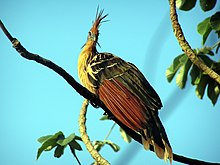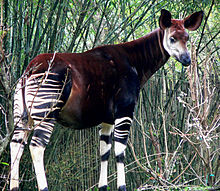Folivore
In
Evolution
Herbivory has evolved several times among different groups of animals. The first vertebrates were small fish that consumed
Folivory and flight

It has been observed that folivory is extremely rare among flying vertebrates.[3] Morton (1978) attributed this to the fact that leaves are heavy, slow to digest, and contain little energy relative to other foods.[3] The hoatzin is an example of a flighted, folivorous bird. There are, however, many species of folivorous flying insects.
Some bats are partially folivorous; their method of deriving nourishment from leaves, according to Lowry (1989), is to chew up the leaves, swallowing the sap and spitting out the remainder.[4]
Arboreal folivores
Primates
Standard

Folivorous primates are relatively rare in the New World, the primary exception being howler monkeys. One explanation that has been offered is that fruiting and leafing occur simultaneously among New World plants. However a 2001 study found no evidence for simultaneous fruiting and leafing at most sites, apparently disproving this hypothesis.[7]
Examples
Examples of folivorous animals include:

- Mammals:
- Birds: The hoatzin of the Amazon region and the kākāpō of New Zealand
- Reptiles: iguanas[8]
- Insects: various kinds of
- Others: many land gastropodspecies (snails and slugs)
See also
- Consumer-resource systems
- Leaf miner, the folivorous strategy of many insects
References
- ^ a b Jones, S., Martin, R., & Pilbeam, D. (1994) The Cambridge Encyclopedia of Human Evolution. Cambridge: Cambridge University Press
- ^ doi:10.1130/G31182.1.)
{{cite journal}}: CS1 maint: multiple names: authors list (link - ^ a b Do the Power Requirements of Flapping Flight Constrain Folivory in Flying Animals? R. Dudley, G. J. Vermeij Functional Ecology, Vol. 6, No. 1 (1992), pp. 101-104
- ^ Folivory in Bats: An Adaptation Derived from Frugivory by T. H. Kunz and K. A. Ingalls; Functional Ecology, Vol. 8, No. 5 (Oct., 1994), pp. 665-668
- ^ a b Cautious climbing and folivory: a model of hominoid differentation E. E. Sarmiento1 in Human Evolution Volume 10, Number 4, August, 1995
- ISSN 1432-0762
- S2CID 8344876.
- ^ "The Diet of a Generalized Folivore: Iguana iguana in Panama". www.anapsid.org. Retrieved 2024-02-05.
